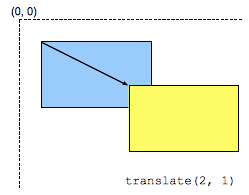The translate() CSS function moves the position of the element on the plane. This transformation is characterized by a vector whose coordinates define how much it moves in each direction.

Syntax
translate(tx) or translate(tx, ty)
Values
- tx
- Is a
<length>representing the abscissa of the translating vector. - ty
- Is a
<length>representing the ordinate of the translating vector. If unspecified, it will equal0:translate(2)meanstranslate(2, 0).
| Cartesian coordinates on ℝ2 | Homogeneous coordinates on ℝℙ2 | Cartesian coordinates on ℝ3 | Homogeneous coordinates on ℝℙ3 |
|---|---|---|---|
|
A translation is not a linear transform in ℝ2 and cannot be represented using a matrix in the cartesian coordinates system. |
|||
[1 0 0 1 tx ty] |
Examples
Using a single axis translation
HTML
<p>foo</p> <p class="transformed">bar</p> <p>foo</p>
CSS
p {
width: 50px;
height: 50px;
background-color: teal;
}
.transformed {
transform: translate(10px);
/* equivalent to translateX(10px)*/
background-color: blue;
}
Result
Combining y-axis and x-axis translation
HTML
<p>foo</p> <p class="transformed">bar</p> <p>foo</p>
CSS
p {
width: 50px;
height: 50px;
background-color: teal;
}
.transformed {
transform: translate(10px,10px);
background-color: blue;
}
Result
Document Tags and Contributors
Tags:
Contributors to this page:
mrstork,
SphinxKnight
Last updated by:
mrstork,